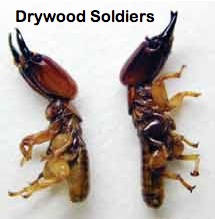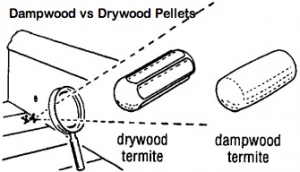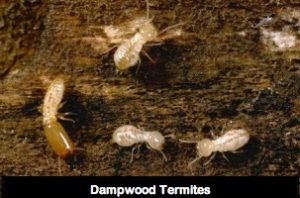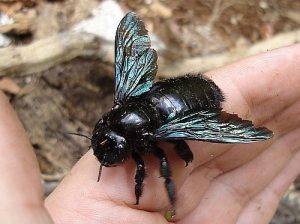What Kind of Termites do I have?

Is it a termite or an ant? Many people are confused when they see 'flying ants' and cannot determine if the insect is truly an ant or a termite. Obviously, it is important to know the difference. This image should help you decide what kind of insect it is.
Ants and termites can be distinguished by three main characteristics:
- The ant's body is constricted, giving it the appearance of having a thin waist; the termite's body is not constricted.
- The ant's hind wings are smaller than its front wings; the termite's front and hind wings are about the same size. (Shortly after their flights, both ants and termites lose their wings, so wings may not always be present.)
- Winged female and worker ants have elbowed antennae; the termite's antennae are not elbowed.
If in doubt, we will identify the pest for you. Mail us your sample along with your phone number; we'll ID your unwelcome guest and call with the results. Or, you can email us and include a picture: Email Us!
There are more than 2,500 different types of termites in the world and at least 17 different types of termites in California. However, most of this diversity can be lumped into four distinct groups: dampwood, drywood, subterranean, and mound builders. Mound builders do not occur in North America, but the other three species do. Dampwood termites are very limited in their distribution: most species are found only in California and the Pacific Northwest. Dampwood termites derive their name from the fact that they live and feed in very moist wood, especially in stumps and fallen trees on the forest floor. Drywood termites are common on most continents and can survive in very dry conditions, even in dead wood in deserts. They do not require contact with moisture or soil. Subterranean termites are very numerous in many parts of the world and live and breed in soil, sometimes many feet deep.
It is important to know what kind of problem you are facing. These descriptions and images should help you determine if you need a professional to take a closer look.
Drywood Termites
 Drywood and subterranean termites are the most destructive insect pests of wood, causing more than $1.7 billion in damages and cost of control each year in the U.S. alone. Their presence in structures is seldom noticed until damage is discovered or the termites swarm within the building. Drywood termites are found in the southern tier of states, from North Carolina through the Gulf Coast and into the coastal areas of California.
Drywood and subterranean termites are the most destructive insect pests of wood, causing more than $1.7 billion in damages and cost of control each year in the U.S. alone. Their presence in structures is seldom noticed until damage is discovered or the termites swarm within the building. Drywood termites are found in the southern tier of states, from North Carolina through the Gulf Coast and into the coastal areas of California.
General Biology
 Drywood termites are social insects that live in colonies in sound, dry wood. Each colony consists of offspring from an original pair (male and female). There are three growth stages – eggs, immatures and adults. Drywood termites are larger than local, southwestern subterranean species. In comparison to other termites drywood colonies are rather small (a few thousand individuals), and the colony develops relatively slowly. They neither live in the ground nor maintain contact with the soil, and they do not build mud tubes.
Drywood termites are social insects that live in colonies in sound, dry wood. Each colony consists of offspring from an original pair (male and female). There are three growth stages – eggs, immatures and adults. Drywood termites are larger than local, southwestern subterranean species. In comparison to other termites drywood colonies are rather small (a few thousand individuals), and the colony develops relatively slowly. They neither live in the ground nor maintain contact with the soil, and they do not build mud tubes.
 Drywood termites produce characteristic feces called pellets. These pellets are eliminated from the galleries through “kick holes”. Pellets tend to accumulate on surfaces located below the kick holes and are usually the first evidence of a drywood termite infestation. Drywood termites tend to cut across wood grain destroying both the soft spring wood and the harder summer growth. Subterranean termites typically follow the grain of the wood, feeding primarily on the soft spring wood.
Drywood termites produce characteristic feces called pellets. These pellets are eliminated from the galleries through “kick holes”. Pellets tend to accumulate on surfaces located below the kick holes and are usually the first evidence of a drywood termite infestation. Drywood termites tend to cut across wood grain destroying both the soft spring wood and the harder summer growth. Subterranean termites typically follow the grain of the wood, feeding primarily on the soft spring wood.
 The reproductives are winged (alates or swarmers) or wingless males and females that produce offspring. The primary reproductives, also called swarmers or alates, vary in body color from dark brown to light yellowish tan. Their wings may be almost clear to smoke gray, and have few distinct veins in them. Swarmer drywood termites are about 7/16 inch long, including the wings. If the primary reproductives die, they are replaced by immatures that can become capable of reproductive activity. They are known as replacement or secondary reproductives.
The reproductives are winged (alates or swarmers) or wingless males and females that produce offspring. The primary reproductives, also called swarmers or alates, vary in body color from dark brown to light yellowish tan. Their wings may be almost clear to smoke gray, and have few distinct veins in them. Swarmer drywood termites are about 7/16 inch long, including the wings. If the primary reproductives die, they are replaced by immatures that can become capable of reproductive activity. They are known as replacement or secondary reproductives.
Dampwood Termites
 Dampwood termites are fairly common in central and northern coastal areas in California. They nest in wood buried in the ground, although contact with the ground is not necessary when infested wood is high in moisture. Because of their high moisture requirements, dampwood termites most often are found in cool, humid areas along the coast and are typical pests of beach houses. Winged reproductives typically swarm between July and October, but it is not unusual to see them at other times of the year. Dampwood termite winged reproductives (sometimes called swarmers) are attracted to lights. Dampwood termites produce distinctive fecal pellets that are rounded at both ends, elongate, and lack the clear longitudinal ridges common to drywood termite pellets. Final confirmation of pellet identification may require help from an expert.
Dampwood termites are fairly common in central and northern coastal areas in California. They nest in wood buried in the ground, although contact with the ground is not necessary when infested wood is high in moisture. Because of their high moisture requirements, dampwood termites most often are found in cool, humid areas along the coast and are typical pests of beach houses. Winged reproductives typically swarm between July and October, but it is not unusual to see them at other times of the year. Dampwood termite winged reproductives (sometimes called swarmers) are attracted to lights. Dampwood termites produce distinctive fecal pellets that are rounded at both ends, elongate, and lack the clear longitudinal ridges common to drywood termite pellets. Final confirmation of pellet identification may require help from an expert.
Subterranean Termites
 Subterranean termites require moist environments. To satisfy this need, they usually nest in or near the soil and maintain some connection with the soil through tunnels in wood or through shelter tubes they construct. These shelter tubes are made of soil with bits of wood or even plasterboard (drywall). Much of the damage they cause occurs in foundation and structural support wood. Because of the moisture requirements of subterranean termites, they are often found in wood that has wood rot.
Subterranean termites require moist environments. To satisfy this need, they usually nest in or near the soil and maintain some connection with the soil through tunnels in wood or through shelter tubes they construct. These shelter tubes are made of soil with bits of wood or even plasterboard (drywall). Much of the damage they cause occurs in foundation and structural support wood. Because of the moisture requirements of subterranean termites, they are often found in wood that has wood rot.
 The western subterranean termite, is the most destructive termite found in California. Reproductive winged forms of subterranean termites are dark brown to brownish black, with brownish gray wings. On warm, sunny days following fall or sometimes spring rains, swarms of reproductives may be seen. Soldiers are wingless with white bodies and pale yellow heads. Their long, narrow heads have no eyes. Workers are slightly smaller than reproductives, wingless, and have a shorter head than soldiers; their color is similar to that of soldiers. In the desert areas of California, Heterotermes aureus, is the most destructive species of subterranean termites.
The western subterranean termite, is the most destructive termite found in California. Reproductive winged forms of subterranean termites are dark brown to brownish black, with brownish gray wings. On warm, sunny days following fall or sometimes spring rains, swarms of reproductives may be seen. Soldiers are wingless with white bodies and pale yellow heads. Their long, narrow heads have no eyes. Workers are slightly smaller than reproductives, wingless, and have a shorter head than soldiers; their color is similar to that of soldiers. In the desert areas of California, Heterotermes aureus, is the most destructive species of subterranean termites.
Life Cycle
 Most termite species swarm in late summer or fall, although spring swarms are not uncommon for subterranean and drywood termites. New kings and queens are winged during their early adult life but lose their wings after dispersing from their original colony. An infestation begins when a mated pair finds a suitable nesting site near or in wood and constructs a small chamber, which they enter and seal. Soon afterward, the female begins egg laying, and both the king and queen feed the young on predigested food until they are able to feed themselves. Most species of termites have microscopic, one-celled animals called protozoa within their intestines that help in converting wood (cellulose) into food for the colony.
Most termite species swarm in late summer or fall, although spring swarms are not uncommon for subterranean and drywood termites. New kings and queens are winged during their early adult life but lose their wings after dispersing from their original colony. An infestation begins when a mated pair finds a suitable nesting site near or in wood and constructs a small chamber, which they enter and seal. Soon afterward, the female begins egg laying, and both the king and queen feed the young on predigested food until they are able to feed themselves. Most species of termites have microscopic, one-celled animals called protozoa within their intestines that help in converting wood (cellulose) into food for the colony.
Once workers and nymphs are produced, the king and queen are fed by the workers and cease feeding on wood. Termites go through incomplete metamorphosis with egg, nymph, and adult stages. Nymphs resemble adults but are smaller and are the most numerous stage in the colony. They also groom and feed one another and other colony members.
Carpenter Ants
 Several species of carpenter ants (Camponotus species) are capable of damaging wood in buildings and other structures. The two most destructive species in the Western United States are C. modoc and C. vicinus, both of which are found in California. Carpenter ants can become pests in any urban setting with ornamental shade trees, but they are particularly common in forested foothill and mountain communities.
Several species of carpenter ants (Camponotus species) are capable of damaging wood in buildings and other structures. The two most destructive species in the Western United States are C. modoc and C. vicinus, both of which are found in California. Carpenter ants can become pests in any urban setting with ornamental shade trees, but they are particularly common in forested foothill and mountain communities.
Identification
Carpenter ants are among the largest ants in North America with workers of C. modoc and C. vicinus ranging from 1/4 to 1/2 long. They have only one bulge at their narrow “waist” (the single node on their petiole) and an evenly rounded back, when viewed from the side (known as a smooth dorsal thoracic profile).
The western black carpenter ant, C. modoc, is uniformly black with dark red legs, while C. vicinus varies in color but usually is red and black. A smaller, yellow and black species, C. clarithorax, which also is common in California, ranges from a little longer than 1/8 of an inch to not quite 5/16 of an inch long.
Carpenter ants can't sting but can inflict painful bites with their powerful jaws and spray formic acid into the wound, causing a burning sensation.
Homeowners might confuse the winged males and females that leave the nest on mating flights with termites. However, you can distinguish between ants and termites by the differences in their antennae, waist, and wings. Also, carpenter ant sawdust is fibrous versus the 6-sided shaped pellets of drywood termites.
Damage
Carpenter ants don’t consume wood like termites but excavate it to make their nests, which in large colonies can consist of an extensive network of galleries and tunnels often beginning in an area where there is damage from water or wood decay. From here they can expand the nest into sound wood and compromise structural integrity. They also commonly nest in wall voids, hollow doors, and insulation. Infestations can even occur in new buildings when land clearing in the surrounding area disturbs established colonies, causing them to move into the structure.
Carpenter Bees
Carpenter bees build nests in wood, creating galleries that can weaken structures; however, they rarely cause severe damage. People may be frightened by carpenter bees because of their large size, their similarity to bumble bees, and their annoying noise.
Identification
 Most carpenter bees, are large and robust insects resembling bumble bees. They are usually about 1 inch long and colored a metallic blue-black with green or purplish reflections. They differ from bumble bees in that their abdomen is shiny with fringes of hairs on some segments. Males of some species are lighter colored, ranging into golden or buff hues.
Most carpenter bees, are large and robust insects resembling bumble bees. They are usually about 1 inch long and colored a metallic blue-black with green or purplish reflections. They differ from bumble bees in that their abdomen is shiny with fringes of hairs on some segments. Males of some species are lighter colored, ranging into golden or buff hues.
Damage
Carpenter bees cause damage to wooden structures by boring into timbers and siding to prepare nests. The nests weaken structural wood and leave unsightly holes and stains on building surfaces. Sound, undecayed wood without paint or bark is usually selected for nests. Carpenter bees also frequently attack dead wood on trees or lumber from southern yellow pine, white pine, California redwood, cedar, Douglas fir, cypress, mimosa, mulberry, ash, and pecan trees. They avoid most hard woods. The presence of carpenter bees around buildings and wooden structures can be annoying or even frightening; however, males cannot sting and females rarely attack.
Dry Rot Fungus
 Dry rot is caused by a fungus and is the most damaging destroyer of wood construction materials in temperate regions. The geographical source of spread and colonization by this fungus in human environments is somewhat of an enigma. According to the National Institute of Health, dry rot fungus is divided into two main lineages; one nonaggressive residing naturally in North America and Asia and another aggressive lineage including specimens from all continents, both from natural environments and buildings.
Dry rot is caused by a fungus and is the most damaging destroyer of wood construction materials in temperate regions. The geographical source of spread and colonization by this fungus in human environments is somewhat of an enigma. According to the National Institute of Health, dry rot fungus is divided into two main lineages; one nonaggressive residing naturally in North America and Asia and another aggressive lineage including specimens from all continents, both from natural environments and buildings.
Genetic analyses indicates that the two lineages represent well-differentiated species and pinpoint mainland Asia as the origin of the aggressive form var. lacrymans. A few aggressive genotypes have migrated worldwide from Asia to Europe, North and South America and Oceania followed by local population expansions. Studies indicate that they have established through recent migration events, for example by infected wood materials transported over land or sea. A separate colonization has happened from mainland Asia to Japan.
This information courtesy of the following National Institutes of Health publication: Asian origin and rapid global spread of the destructive dry rot fungus Serpula lacrymans.
Dry Rot spores are everywhere in the atmosphere, and if the condition of the timber becomes suitable, is it likely that the spores will germinate and result in an outbreak of decay. The main requirement is that the timber moisture content is in excess of 20%. This is not a very high level in view of "dry air" timber having a moisture content of between 12 - 16%. Certain timbers are resistant to fungial attack, even when very damp, but these are not generally used in house construction. A large fruiting body of the fungus can produce 800 - 900 million spores per hour. In ideal conditions its growth is very rapid, and will soon cause the timber to become cracked both with and across the grain.
Serpula lacrymans (Dry Rot) has a preference for dark conditions, inadequately ventilated places, and often remains undetected until severe damage has been caused. Often the first knowledge the householder has of its presence is the cracking and/or buckling of skirting boards or rust brown spore dust. It is capable of spreading behind plaster, through mortar joints, and even across metal to find more timber or moisture to feed on. i.e. a non nutrient medium.


